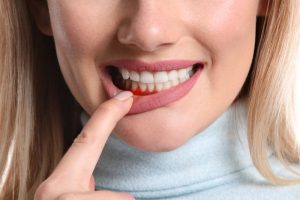Can I be Infected with Gum Disease from Another Person?
April 6, 2021

Over 60% of adults in America have gingivitis or a more acute form of gum disease, which is the inflammation and infection of the soft tissue inside the mouth. What does this mean for the rest of the population? Are they at risk of being infected with the condition from other people? A local dentist answers and explains how to fortify your gum health.
Understanding Gum Disease
The first stage of gum disease is gingivitis. At this point, any damage that is incurred can be reversed. However, if ignored, gingivitis can soon morph into periodontal disease and, eventually, the more devastating periodontitis. Ongoing neglect can further lead to permanent damage to the connective tissue and bone that lie beneath the gum line, tooth loss and infection that spreads to other parts of the body.
Is Gum Disease Contagious?
Gum disease can be contagious. However, in comparison to the common cold, flu, stomach viruses, COVID and other illnesses, its contagiousness pales in comparison. Still, it’s better to err on the side of safety.
The primary way that gum disease can be transmitted from person-to-person is through saliva. Here are specific situations to be mindful of:
- Kissing – While it’s not typical to develop gum disease by kissing, it’s still a possibility, as billions of bacteria can be found in the saliva. Babies are the most susceptible to complications from adults with gingivitis kissing them, as their immune systems aren’t completely developed.
- Sharing Drinks – When a person takes a sip of a beverage, saliva can be left on the cup or straw. If another person with already compromised health takes a sip, there is a much greater chance of him or her developing gum disease.
- Sharing Toothbrushes and Utensils – It’s also best to avoid using someone else’s toothbrush or eating utensils, as the left behind saliva can contain billions of germs and bacteria that could lead to gum disease.
Preventing Gum Disease
While periodontal therapy in Belchertown, which ranges from a scaling and root planing procedure to the usage of the antibiotic Arestin, can be used to restore gum health, prevention is the most effective form of treatment.
It starts with limiting your consumption of sugar, as it attracts bacteria. It’s also of the utmost importance to practice excellent oral hygiene, which should include brushing and flossing at least two times a day. The final way to protect your teeth and gums is to visit a dentist every six months for cleanings and examinations.
The sooner any signs of gum disease are noticed and treated, the less problems you’ll have to endure. And by taking the more proactive route, you can enjoy healthy teeth and gums for the rest of your life!
About the Author
Dr. Mark D. Medaugh earned his dental degree from the University of Pennsylvania. Coming from a family of dentists, he maintains a deep commitment to helping his patients experience the absolute best in oral health. Along the way, Dr. Medaugh has remained an avid learner, taking several hours of continuing education to expand his knowledge. He provides periodontal therapy at Valley Dentists of Belchertown, and he can be reached for more information or to schedule a visit through his website.
No Comments
No comments yet.
RSS feed for comments on this post.
Sorry, the comment form is closed at this time.







